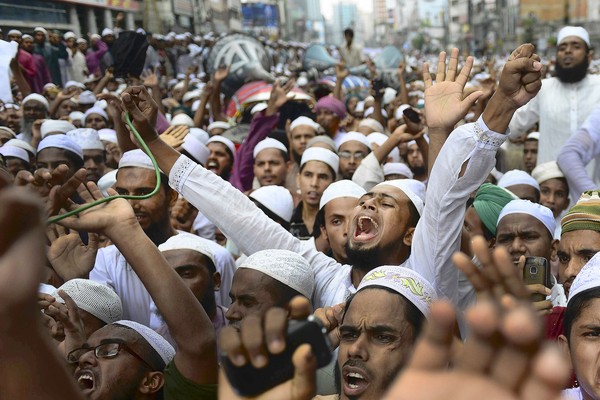 Originally posted at American Thinker. blog
Originally posted at American Thinker. blog
Barack Obama prides himself on being a community organizer — stirring up the disgruntled in Chicago was the sole skill set that earned him the esteemed title of Leader of the Free World.
Using Saul Alinsky’s Rules for Radicals as a road map, Barack Obama not only community organized, but taught others how to follow his lead. Young Obama instructed students that to make a statement that would inspire change, they’d have to be well-practiced in the art of street-level confrontation, picketing, demonstrating, and all-out pandemonium.
He was very good at what he did. Saul Alinsky-style organizers were taught to be “an abrasive agent to rub raw the resentments of the people of the community; to fan latent hostilities of many of the people to the point of overt expressions” which, ironically, is exactly what the world is witnessing as the Middle East is ablaze with street-level hatred.
For days the world has watched in growing horror as the fires of animosity have spread. Yet for those wondering why Barack Obama isn’t addressing more firmly the upheaval in the Islamic world, a simple answer might be that one community organizer can’t very well criticize another community organizer’s style of community organizing, now can he?
Back in Chicago, Barack Obama encouraged the underprivileged to take action on their own behalf by reminding the already resentful of past injustices. Wherever and whenever there’s strife, there is surely what Obama called “indigenous…charismatic leadership” nearby. There’s always a ringleader in the group – an individual or a team that possesses the ability to make something happen by getting “people to understand the source of their social or political problems.” In this case the source of the turmoil is rooted in religious zealotry.
Either way, wherever street-level organizing takes place and regardless of the extent of the mayhem, motivating people to unrest to make a point is really nothing more than a mob leader organizing a group of angry thugs and goading them toward hostile confrontation. Sometimes the resulting action takes place in American cities like Chicago, but other times it erupts in unstable pockets in the world like the ones Barack Obama commiserated with in his book “Dreams From My Father” when he said:
[t]he desperation and disorder of the powerless: how it twists the lives of children on the streets of Jakarta or Nairobi in much the same way as it does the lives of children on Chicago’s South Side, how narrow the path is for them between humiliation and untrammeled fury, how easily they slip into violence and despair.
Barack Obama explained in a chapter he wrote for a 1990 book entitled After Alinsky: Community Organizing in Illinois that the work of a successful community organizer is to devise and map out solutions and strategies with the express goal of moving protesters to “action through campaigns that win concrete changes.” In Chicago, broken streetlights were facilitators to discuss jobs, education and crime. In Cairo, poorly made videos and American infidels are the torches that ignited the flames of unrest in an already unstable situation.
Think about it — thousands of miles away from Chicago, people — angry, vicious people – under the banner of the late al Qaeda leader Osama ‘Alinsky’ Bin Laden are rallying together under the Islam black flag of “common self interest.”
In the Sudan, Tunisia, Egypt, and even in Libya, the means to the end may be more violent and destructive than what went down on the Southside of Chicago, but it’s the same philosophy at work. In Chicago, picketing opened the door to demanding stop signs be fixed and progressed from there. In Benghazi, it started with burning American flags; an embassy was then destroyed and innocent lives were lost as ancient grievances were resurrected from the hot desert sand to make a statement against America, the Great Satan, and Isaac, Ishmael’s arch enemy, also known as the nation of Israel.
Whether residing in Chicago, Washington DC, or a remote compound in Pakistan, in their efforts to “make something happen,” community organizers have their own unique ways of applying conflict for change.
Although the gripes and tactics are more primitive, what is actually happening in the Islamic world is simply this: common people with a common agenda are coming together, in their own uniquely violent way, to address a common concern. In Obama’s Chicago, the goal was to whip up the community to a “fighting pitch” to address political and social justice. In this case, the goal is clearly to deliver “Death to America.”
Similar to Alinsky’s recommendations in his radical rules handbook, Middle Eastern protesters are merely exhibiting neighborhood empowerment in a culturally innovative way. From a tactical point of view, any community organizer worth his salt would have to admit that the community-organizing stratagem Barack Obama so closely identifies with is what is now crudely on display in the Arab world.
Maybe that explains why the perpetually fundraising Barack Obama is hesitant to criticize the chaos; he recognizes that what’s going on thousands of miles from Chicago is an impressive show of “collective power,” where a community vision has moved our Muslim brothers and sisters to action. It could be that our Community Organizer-in-Chief, who once praised people for “reshap[ing] their mutual values and expectations and rediscover[ing] the possibilities of acting collaboratively,” actually believes that throwing stones, ambushing diplomats, and burning American flags is just another kind of neighborhood effort to foster lasting change.
